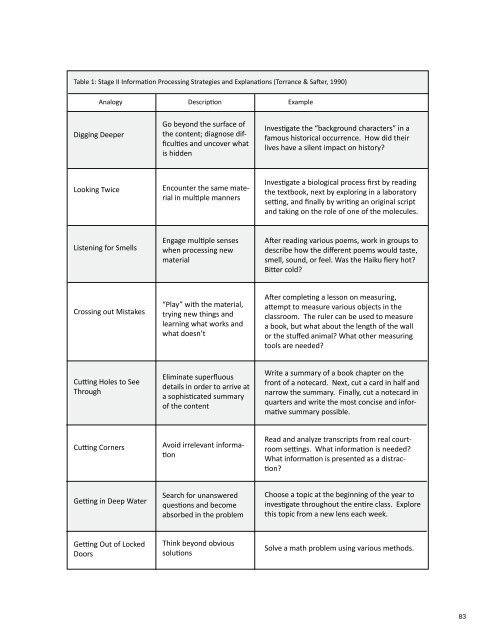Torrance Journal for Applied Creativity
TorranceJournal_V1
TorranceJournal_V1
Create successful ePaper yourself
Turn your PDF publications into a flip-book with our unique Google optimized e-Paper software.
Table 1: Stage II In<strong>for</strong>mation Processing Strategies and Explanations (<strong>Torrance</strong> & Safter, 1990)<br />
Analogy Description Example<br />
Digging Deeper<br />
Go beyond the surface of<br />
the content; diagnose difficulties<br />
and uncover what<br />
is hidden<br />
Investigate the “background characters” in a<br />
famous historical occurrence. How did their<br />
lives have a silent impact on history?<br />
Looking Twice<br />
Encounter the same material<br />
in multiple manners<br />
Investigate a biological process first by reading<br />
the textbook, next by exploring in a laboratory<br />
setting, and finally by writing an original script<br />
and taking on the role of one of the molecules.<br />
Listening <strong>for</strong> Smells<br />
Engage multiple senses<br />
when processing new<br />
material<br />
After reading various poems, work in groups to<br />
describe how the different poems would taste,<br />
smell, sound, or feel. Was the Haiku fiery hot?<br />
Bitter cold?<br />
Crossing out Mistakes<br />
“Play” with the material,<br />
trying new things and<br />
learning what works and<br />
what doesn’t<br />
After completing a lesson on measuring,<br />
attempt to measure various objects in the<br />
classroom. The ruler can be used to measure<br />
a book, but what about the length of the wall<br />
or the stuffed animal? What other measuring<br />
tools are needed?<br />
Cutting Holes to See<br />
Through<br />
Eliminate superfluous<br />
details in order to arrive at<br />
a sophisticated summary<br />
of the content<br />
Write a summary of a book chapter on the<br />
front of a notecard. Next, cut a card in half and<br />
narrow the summary. Finally, cut a notecard in<br />
quarters and write the most concise and in<strong>for</strong>mative<br />
summary possible.<br />
Cutting Corners<br />
Avoid irrelevant in<strong>for</strong>mation<br />
Read and analyze transcripts from real courtroom<br />
settings. What in<strong>for</strong>mation is needed?<br />
What in<strong>for</strong>mation is presented as a distraction?<br />
Getting in Deep Water<br />
Search <strong>for</strong> unanswered<br />
questions and become<br />
absorbed in the problem<br />
Choose a topic at the beginning of the year to<br />
investigate throughout the entire class. Explore<br />
this topic from a new lens each week.<br />
Getting Out of Locked<br />
Doors<br />
Think beyond obvious<br />
solutions<br />
Solve a math problem using various methods.<br />
83


